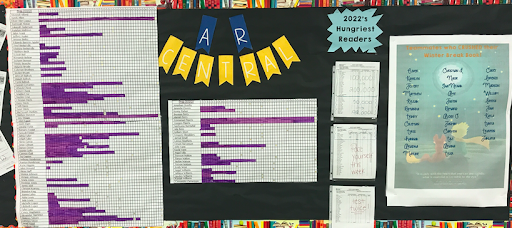At any moment of the day, a variety of stimuli are vying for our students’ attention. Video games. Instagram. Snapchat. Twitter. Texting. Facetime. The list goes on and on. Thus, in order for a kid to choose a book over all the other competing options, we must cultivate a culture of reading. Reading must be equally as “cool” as Fortnite. Period. Here are three tips for cultivating a culture of reading in your classrooms and schools.

Tip 1: Know What’s Trending
In order to appeal to your students, especially to your developing readers, you have to know what’s hot and what’s not. Accelerated Reader releases an annual “What Kids Are Reading” report. The report breaks down books preferred by certain age groups and by gender. This is an excellent place to start when growing your own classroom library or giving students book recommendations. I have found that families will, at times, be concerned that their child is only reading graphic novels (i.e., Diary of a Wimpy Kid, Captain Underpants, Dog Man). My mantra has always been, “That is OKAY! Let’s get them to love reading FIRST and then we will expand their genre appreciation.” If you force a developing reader to sit down with Lord of The Flies, chances of them continuing to read beyond that text are slim. However, if they choose to read all 25 Diary of a Wimpy Kid books, then they are building habits of a reader, subconsciously teaching their brain that reading is enjoyable (and funny), and are much more likely to engage with a more difficult text in the future. And YOU just made reading as “cool” as Fortnite.
Tip 2: Leverage Your Influencers
Why did people spend thousands of dollars hoping to attend the Fyre Festival? Influencers. How can you cultivate a culture of reading in your classroom? Influencers. Consider which students in your classroom carry weight with their peers. Who are the leaders that others tend to follow? Those are the students to win over as readers first. Find out what they like, their passions, their interests, and get them hooked on a couple of books. Then, have them share about their books with their peers. Here are some booktalk resources from my classroom. Post their reviews around the classroom with a picture of the book cover and allow the student to post their book review on Amazon after completing their booktalk. If models can influence complete strangers to purchase tickets for a non-existent festival by posting a simple orange tile, student leaders can influence their peers and friends to read great books.
Tip 3: Incentivize. Incentivize. Incentivize.
This does not necessarily need to involve money. By merely publicly tracking students’ reading you will see an increased interest in reading. Whether you track books read, words read, AR points — make it public and proud and watch students read, baby, read. Here are two photos of AR tracking in the Henderson Collegiate hallways.


Create a comfy area in your classroom that feels different. Kids can earn getting “in the zone” with their book by reaching their goal or finishing a book in a new genre! Here’s a picture of my “Collegiate Corner” from my 7th grade ELA classroom.

Celebrate when students reach their goal. I’ve been at schools that made a big deal out of students reading a million words. We tracked their word counts and when students reached “millionaire status” they earned a t-shirt only to be earned and worn by the millionaires. Talk about making something cool! At Democracy Prep Baton Rouge we even tiered millionaire status. First time millionaire: 1 million words – short sleeve millionaire t-shirt. Second time millionaire: 1.2 million words – long sleeve millionaire shirt. Third time millionaire: 1.5 million words – millionaire sweatshirt. Fourth time millionaire: 1.5 million words read – millionaire hoodie.

Encourage families to incentivize reading and send you pictures of their children “caught reading” — you will start to see students trying to get caught reading. That’s when you know you have begun to cultivate a true culture of reading.

Host a read-a-thon, or reading marathon! If able, have students wear joggers and sweatbands and bring a comfortable item (pillow or stuffed animal) to school. Create a large open space and let students spread out, find a little nook and read without getting distracted! Every 20-30 minutes try to distract students to get them “out” and celebrate the students that last the longest. I’ve included some resources here for running a read-a-thon.
Join with me in closing the literacy gap by creating a culture of reading in your classrooms and schools! Other ideas? Comment below!
 Meghan Thompson joined Teach For America in 2008 and began her career in education as a 9th-12th Special Education Teacher in Charlotte, NC. In 2010, she was a member of the founding team at Henderson Collegiate (a school that has ranked in the top 3.5% of all NC public schools for the past 4 years). In 2014, she was a member of the founding team at Democracy Prep Baton Rouge and throughout her time at DPBR served as a middle school ELA teacher, middle school math teacher and the Middle School Campus Director.
Meghan Thompson joined Teach For America in 2008 and began her career in education as a 9th-12th Special Education Teacher in Charlotte, NC. In 2010, she was a member of the founding team at Henderson Collegiate (a school that has ranked in the top 3.5% of all NC public schools for the past 4 years). In 2014, she was a member of the founding team at Democracy Prep Baton Rouge and throughout her time at DPBR served as a middle school ELA teacher, middle school math teacher and the Middle School Campus Director.


2 comments